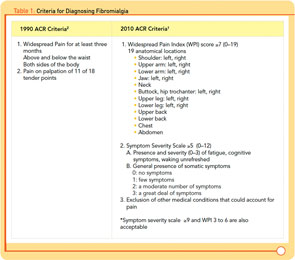For the 2010 criteria, 113 rheumatologists identified fibromyalgia patients in their clinic who had been diagnosed previously by them. Those patients were not required to meet the 1990 criteria to be included. The requirement was that patients were diagnosed with fibromyalgia, even if the diagnosis was based on symptom complaints rather than physical findings.
The committee also considered how to categorize and assess patients with fibromyalgia whose symptoms improved so that they no longer met the 1990 criteria. They added a symptom severity scale in the 2010 criteria as a tool to quantify the symptoms of these patients over time and to differentiate among patients according to the level of fibromyalgia symptoms. Cognitive impairment, fatigue, and waking unrefreshed, along with the degree of general somatic complaints, comprise the symptom severity scale. Additionally, the 2010 fibromyalgia criteria include the widespread pain index score based on presence of pain at 19 anatomical sites and excluding other causes of widespread pain.
Rationale for Revision
Three realities drove the need to revise the ACR fibromyalgia criteria. First, there was the way the 1990 criteria, which were intended for classification and not diagnosis, were being applied in general practice. More problematic was that people had mistakenly thought the tender point exam was the essence of the 1990 criteria. “The tender point exam is a proxy for the widespread hyperalgesia present in fibromyalgia. Somehow, that point never got through to clinicians,” says Dr. Goldenberg. “Patients are not bothered by tender points. The tender point exam did not emphasize the major features of fibromyalgia such as the extent of the pain, fatigue, sleep disturbance, multiple somatic symptoms, and cognitive difficulties,” says Dr. Wolfe.
Daniel Clauw, MD, professor of medicine, anesthesiology, and psychiatry at the University of Michigan in Ann Arbor, and 2010 fibromyalgia criteria committee member, notes, “no other syndrome required anything like tender points, a physical sign that had no impact on clinical outcomes.”
The third rationale was that the old criteria failed to allow for continuum and hetereogeneity in fibromyalgia presentation beyond pain. “If you have only 10 tender point points, are you really a healthy normal person?” says Dr. Wolfe.
“Memory problems and fatigue are a significant part of the illness, but the 1990 criteria failed to give them weight and only captured the pain element,” says Dr Clauw. Dr. Wolfe found in previous research that when tracking symptoms, patients vacillated between meeting and not meeting the 1990 criteria. In fact, in the 2010 criteria study, one in four patients did not meet the 1990 criteria. The actual level of symptoms was more important than whether or not patients satisfied the 1990 criteria. Hence, creating a symptom severity scale was the fourth major rationale revising the fibromyalgia criteria.



